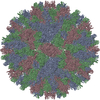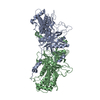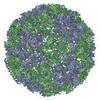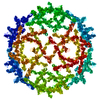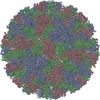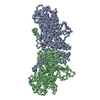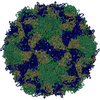[English] 日本語
 Yorodumi
Yorodumi- EMDB-2390: The limits of structural plasticity in a picornavirus capsid reve... -
+ Open data
Open data
- Basic information
Basic information
| Entry | Database: EMDB / ID: EMD-2390 | |||||||||
|---|---|---|---|---|---|---|---|---|---|---|
| Title | The limits of structural plasticity in a picornavirus capsid revealed by a massively expanded equine rhinitis A virus particle | |||||||||
 Map data Map data | Reconstruction of expanded equine rhinitis A virus | |||||||||
 Sample Sample |
| |||||||||
 Keywords Keywords |  virus / virus /  picornavirus / capsid structure / capsid expansion / picornavirus / capsid structure / capsid expansion /  uncoating uncoating | |||||||||
| Function / homology |  Function and homology information Function and homology informationicosahedral viral capsid / host cell cytoplasm / symbiont entry into host cell / structural molecule activity / virion attachment to host cell /  cytoplasm cytoplasmSimilarity search - Function | |||||||||
| Biological species |  Equine rhinitis A virus Equine rhinitis A virus | |||||||||
| Method |  single particle reconstruction / single particle reconstruction /  cryo EM / Resolution: 17.0 Å cryo EM / Resolution: 17.0 Å | |||||||||
 Authors Authors | Bakker SE / Groppelli E / Pearson AR / Stockley PG / Rowlands DJ / Ranson NA | |||||||||
 Citation Citation |  Journal: J Virol / Year: 2014 Journal: J Virol / Year: 2014Title: Limits of structural plasticity in a picornavirus capsid revealed by a massively expanded equine rhinitis A virus particle. Authors: Saskia E Bakker / Elisabetta Groppelli / Arwen R Pearson / Peter G Stockley / David J Rowlands / Neil A Ranson /  Abstract: The Picornaviridae family of small, nonenveloped viruses includes major pathogens of humans and animals. They have positive-sense, single-stranded RNA genomes, and the mechanism(s) by which these ...The Picornaviridae family of small, nonenveloped viruses includes major pathogens of humans and animals. They have positive-sense, single-stranded RNA genomes, and the mechanism(s) by which these genomes are introduced into cells to initiate infection remains poorly understood. The structures of presumed uncoating intermediate particles of several picornaviruses show limited expansion and some increased porosity compared to the mature virions. Here, we present the cryo-electron microscopy structure of native equine rhinitis A virus (ERAV), together with the structure of a massively expanded ERAV particle, each at ∼17-Å resolution. The expanded structure has large pores on the particle 3-fold axes and has lost the RNA genome and the capsid protein VP4. The expanded structure thus illustrates both the limits of structural plasticity in such capsids and a plausible route by which genomic RNA might exit. IMPORTANCE: Picornaviruses are important animal and human pathogens that protect their genomic RNAs within a protective protein capsid. Upon infection, this genomic RNA must be able to leave the ...IMPORTANCE: Picornaviruses are important animal and human pathogens that protect their genomic RNAs within a protective protein capsid. Upon infection, this genomic RNA must be able to leave the capsid to initiate a new round of infection. We describe here the structure of a unique, massively expanded state of equine rhinitis A virus that provides insight into how this exit might occur. | |||||||||
| History |
|
- Structure visualization
Structure visualization
| Movie |
 Movie viewer Movie viewer |
|---|---|
| Structure viewer | EM map:  SurfView SurfView Molmil Molmil Jmol/JSmol Jmol/JSmol |
| Supplemental images |
- Downloads & links
Downloads & links
-EMDB archive
| Map data |  emd_2390.map.gz emd_2390.map.gz | 25.9 MB |  EMDB map data format EMDB map data format | |
|---|---|---|---|---|
| Header (meta data) |  emd-2390-v30.xml emd-2390-v30.xml emd-2390.xml emd-2390.xml | 8.9 KB 8.9 KB | Display Display |  EMDB header EMDB header |
| Images |  emd_2390.png emd_2390.png | 268.6 KB | ||
| Archive directory |  http://ftp.pdbj.org/pub/emdb/structures/EMD-2390 http://ftp.pdbj.org/pub/emdb/structures/EMD-2390 ftp://ftp.pdbj.org/pub/emdb/structures/EMD-2390 ftp://ftp.pdbj.org/pub/emdb/structures/EMD-2390 | HTTPS FTP |
-Related structure data
| Related structure data |  4ctgMC  2389C  4ctfC M: atomic model generated by this map C: citing same article ( |
|---|---|
| Similar structure data |
- Links
Links
| EMDB pages |  EMDB (EBI/PDBe) / EMDB (EBI/PDBe) /  EMDataResource EMDataResource |
|---|---|
| Related items in Molecule of the Month |
- Map
Map
| File |  Download / File: emd_2390.map.gz / Format: CCP4 / Size: 51.5 MB / Type: IMAGE STORED AS FLOATING POINT NUMBER (4 BYTES) Download / File: emd_2390.map.gz / Format: CCP4 / Size: 51.5 MB / Type: IMAGE STORED AS FLOATING POINT NUMBER (4 BYTES) | ||||||||||||||||||||||||||||||||||||||||||||||||||||||||||||||||||||
|---|---|---|---|---|---|---|---|---|---|---|---|---|---|---|---|---|---|---|---|---|---|---|---|---|---|---|---|---|---|---|---|---|---|---|---|---|---|---|---|---|---|---|---|---|---|---|---|---|---|---|---|---|---|---|---|---|---|---|---|---|---|---|---|---|---|---|---|---|---|
| Annotation | Reconstruction of expanded equine rhinitis A virus | ||||||||||||||||||||||||||||||||||||||||||||||||||||||||||||||||||||
| Voxel size | X=Y=Z: 1.72 Å | ||||||||||||||||||||||||||||||||||||||||||||||||||||||||||||||||||||
| Density |
| ||||||||||||||||||||||||||||||||||||||||||||||||||||||||||||||||||||
| Symmetry | Space group: 1 | ||||||||||||||||||||||||||||||||||||||||||||||||||||||||||||||||||||
| Details | EMDB XML:
CCP4 map header:
| ||||||||||||||||||||||||||||||||||||||||||||||||||||||||||||||||||||
-Supplemental data
- Sample components
Sample components
-Entire : expanded equine rhinitis A virus
| Entire | Name: expanded equine rhinitis A virus |
|---|---|
| Components |
|
-Supramolecule #1000: expanded equine rhinitis A virus
| Supramolecule | Name: expanded equine rhinitis A virus / type: sample / ID: 1000 / Oligomeric state: One icosahedral virus particle / Number unique components: 1 |
|---|
-Supramolecule #1: Equine rhinitis A virus
| Supramolecule | Name: Equine rhinitis A virus / type: virus / ID: 1 / Name.synonym: ERAV / NCBI-ID: 47000 / Sci species name: Equine rhinitis A virus / Virus type: VIRUS-LIKE PARTICLE / Virus isolate: SPECIES / Virus enveloped: No / Virus empty: Yes / Syn species name: ERAV |
|---|---|
| Host (natural) | Organism:   Equus caballus (horse) / synonym: VERTEBRATES Equus caballus (horse) / synonym: VERTEBRATES |
| Host system | Organism:   Homo sapiens (human) / Recombinant cell: HeLa cells Homo sapiens (human) / Recombinant cell: HeLa cells |
| Virus shell | Shell ID: 1 / Diameter: 316 Å |
-Experimental details
-Structure determination
| Method |  cryo EM cryo EM |
|---|---|
 Processing Processing |  single particle reconstruction single particle reconstruction |
| Aggregation state | particle |
- Sample preparation
Sample preparation
| Concentration | 2 mg/mL |
|---|---|
| Grid | Details: 300 mesh quantifoil R1.2/1.3 grids, glow discharged in air. |
| Vitrification | Cryogen name: ETHANE / Instrument: HOMEMADE PLUNGER |
- Electron microscopy
Electron microscopy
| Microscope | FEI TECNAI F20 |
|---|---|
| Electron beam | Acceleration voltage: 200 kV / Electron source:  FIELD EMISSION GUN FIELD EMISSION GUN |
| Electron optics | Calibrated magnification: 87209 / Illumination mode: FLOOD BEAM / Imaging mode: BRIGHT FIELD Bright-field microscopy / Cs: 2 mm Bright-field microscopy / Cs: 2 mm |
| Sample stage | Specimen holder: 626 / Specimen holder model: GATAN LIQUID NITROGEN |
| Date | Jan 1, 2011 |
| Image recording | Category: CCD / Film or detector model: GATAN ULTRASCAN 4000 (4k x 4k) / Average electron dose: 15 e/Å2 |
| Experimental equipment |  Model: Tecnai F20 / Image courtesy: FEI Company |
- Image processing
Image processing
| CTF correction | Details: phase flipping, each particle |
|---|---|
| Final two d classification | Number classes: 78 |
| Final reconstruction | Applied symmetry - Point group: I (icosahedral ) / Algorithm: OTHER / Resolution.type: BY AUTHOR / Resolution: 17.0 Å / Resolution method: FSC 0.5 CUT-OFF / Software - Name: SPIDER / Number images used: 227 ) / Algorithm: OTHER / Resolution.type: BY AUTHOR / Resolution: 17.0 Å / Resolution method: FSC 0.5 CUT-OFF / Software - Name: SPIDER / Number images used: 227 |
 Movie
Movie Controller
Controller



